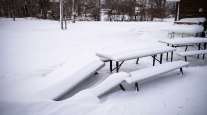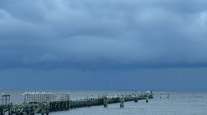Staff Reporter
Fleets Prepare Drivers for Extreme Cold

Trucking groups prepared their drivers for the polar vortex gripping the Midwest with tips on operations and safety.
The blast of arctic cold swept the region for days, plunging temperatures and wind chills to the lowest many Midwestern states had experienced in decades, and forcing some trucking companies to halt deliveries altogether.
Thief River Falls, Minn., saw minus 77 degrees on Jan. 29, according to the National Weather Service, while the mercury plummeted in Grand Forks, N.D., to 65 degrees below zero. By the next day Chicago was at minus 23, and central Iowa down to minus 35.

A UPS truck travels down a street in Chicago on Jan. 30. (Daniel Acker/Bloomberg)
Subsequently the U.S. Postal Service suspended deliveries in parts of 10 states, UPS halted deliveries in certain areas and FedEx warned customers to expect delays. The Federal Motor Carrier Safety Administration relaxed hours-of-service rules for carriers hauling heating fuel for relief efforts as part of an emergency declaration for 22 days.
Freight companies had to be nimble too, some even shuttering terminals.
Mel Simon, president of Lakeville, Minn.-based Styer Transportation, said three of his customers closed Jan. 30. He said this was the first time in his 28-year trucking career that he had seen a customer close due to the cold (wind chills there of 36 degrees below zero).
Simon said that Styer, which specializes in local and over-the-road deliveries with a fleet of 60 trucks, often sends drivers tips on operations and equipment management but for the past few weeks all of the tips were weather-related.
One caution was to watch out for brakes freezing. Moisture can gather on trucks while they’re moving and can freeze when a driver parks overnight, he said. One way to handle the freezing is to pound the ice loose with a hammer, but Simon said moving the truck forward a foot about 10 minutes after parking makes the brakes less likely to freeze. Failing to check brakes before a dispatch can harm the tread on tires.
“It’s something you really have to be careful of,” Simon said. “Otherwise, if you don’t, the brakes loosen and you’re dragging trailers.”
Gary Falldin, vice president of safety, security and driver onboarding for Dart Transit, based in Eagan, Minn., where it was 16 degrees below zero on Jan. 30, advised drivers to have plenty of supplies, such as water, juice, fruit, nuts, spare clothes, a sleeping bag and sturdy boots, in case they get stuck.
In particular, Falldin said drivers should wear warm gear for their pre-trip inspections because a few minutes of handling the freezing cold hood of a truck could result in frostbite.
“Pre-trip is just as important, if not more important, in cold weather as it is during rest of the year, and they need to be able to dress to do that,” Falldin said. “Any time you have this extreme of cold weather, it makes the job for the truck driver so much more difficult.”
Dart ranks No. 68 on the Transport Topics 100 list of largest for-hire carriers in North America.

Kedzie
In neighboring Wisconsin, Neal Kedzie, president of the Wisconsin Motor Carriers Association, said that some beer distributors halted dispatches in rural areas Jan. 30 out of fear that the product would freeze. The state registered bitter cold temperatures throughout. Green Bay, for example, marked 18 degrees below zero and wind chills below 40.
Simon said that truckers based in northern states typically use a blended fuel in the winter that has less moisture and higher octane, resulting in a slimmer chance that the fuel will jell and get stuck in the fuel filter. He said diesel exhaust fluid, which is used to break down harmful emissions, is more likely to freeze than the fuel itself.
Simon advised operators to have their trucks running any time the temperature is below zero and keep additive (which helps prevent fuel from jelling) on hand. He also said truckers should try to find safe parking facilities and shouldn’t be outside for more than 10 minutes at a time.
Dot Transportation Inc., based in Mt. Sterling, Ill., where the low was around minus 9 and wind-chill values as low as minus 20, has four terminals in the path of the vortex. So President Paul Mugerditchian told drivers to minimize exposure and to keep trucks idling.

A Roehl Transport truck in warmer times. (John Sommers II for Transport Topics)
The company is a subsidiary of Dot Foods, No. 22 on the Transport Topics Top 100 list of largest private carriers in North America.
Don Ingersoll, vice president of van operations for Roehl Transport, said some of his company’s customers closed Jan. 30. Based in Gary, Ind., where it was minus 9 and the wind chill minus 31, the company is reaching out to drivers to make sure they can park and to plug in their block heaters, used to keep engines warm.
“The most important thing is to make sure that there’s a safe place to park,” Ingersoll said. “Most of them are just going to have to hunker down and find a safe place to be.”
Roehl, No. 78 on the TT 100 for-hire list, has eight major terminals, four scattered throughout the Midwest.




